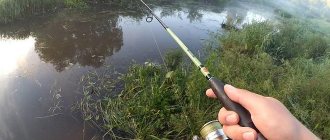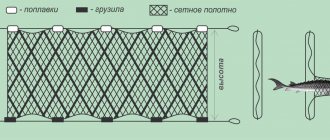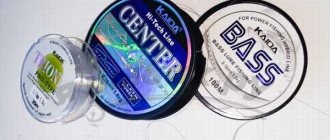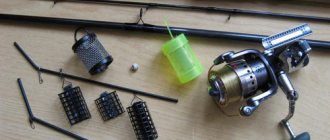Fluorocarbon fishing lines are a relatively new effective type of line that appeared in the angler’s arsenal about four decades ago. The properties of the new product came in handy to provide some specific fishing conditions, and after some time the fishing lines were adapted to almost all fishing methods and firmly occupied their niche in the fishing industry.
Advantages of fishing line
Fluorocarbon fishing line has a number of distinctive advantages compared to monofilament and braided lines. In particular, this material has a high degree of transparency and is hardly noticeable in water . The lack of memory allows you to manipulate the cord, winding, unwinding, making twists and knots of equipment, without fear of permanent residual deformations of the structure. Fluorocarbon fishing line is a type of material with high abrasion resistance, is insensitive to ultraviolet radiation and does not have moisture absorption properties.
In addition, a high degree of rigidity and a low stretch coefficient make the cords sensitive to bites and control of equipment during wiring. Important qualities are frost resistance and low sensitivity to sudden temperature changes, as well as the absence of drying out of the material.
Myth 3 Fluorocarbon is stronger than nylon thread.
There is an opinion and statements from sellers that, with the same diameter, fluorocarbon is stronger than monofilament, this is also not confirmed, but rather refuted by various tests.
Nevertheless, due to the properties of fluorocarbon, this fishing line can be perfectly used in salt water, in reservoirs with severe chemical pollution, if there is a possibility of the fishing line rubbing against stones, it is indeed more resistant to mechanical stress.
It makes excellent leashes and is difficult for predatory fish to bite through. Fluorocarbon makes excellent equipment for feeder fishing.
Everything else is nothing more than a marketing ploy by sellers to increase the cost of their product.
It makes no sense to use it as the main fishing line, as many anglers do, especially in winter fishing, unless you install the fishing rod in such a way that the fishing line rubs against the edge of the hole.
Test results based on which the above statements are made:
Additionally, we suggest that you familiarize yourself with various real tests from different anglers:
Test from Youtube channel|
Youtube Video|
Share link:
Disadvantages of fishing line

Fluorocarbon line is not an ideal material and has a number of significant disadvantages that must be taken into account when choosing the main line of the tackle. This is a fragile structure that is afraid of radical fractures and significantly loses strength characteristics when tying knots. The strength of the material also requires a decent diameter of the fishing line, which is significantly inferior to the characteristics of its braided counterpart. Fluorocarbon fishing line, when linearly expanded or stretched critically, floats in diameter without returning to its original positions. High plasticity is the reason that can spontaneously relax and untie the knot.
How to check fluorocarbon fishing line for authenticity
Sellers of this accessory often commit fraud, offering the buyer not pure fluorescent, but bases coated with fluorocarbon. An experienced angler who has experience working with cords of this type will understand the type of material and is unlikely to make a mistake. But for a novice fisherman, ways to check the original thread will be useful and simply necessary. The simplest way to determine pure fluorine is to test it with fire, or rather, with the flame of a match or lighter.
This procedure can be carried out right at the place of purchase, so that if the seller is dishonest, the goods can be returned. When you ignite the tip of a fake fluor, you will notice a persistent burning of the material, as a result of which, as a result of extinguishing, a frozen dense droplet of black color is formed. Fluorocarbon line resists burning, curling up into dark, dry clumps at the end of the cut. Such simple manipulations allow you to completely understand whether this fishing line is fluorocarbon or not.
Lead material
Fluor is used quite rarely as a long main cord and in particularly exceptional cases. Most often, this type of fishing line is used as a shock leader or, even more practical, as a leader material. The invisibility of the leash, its rigidity and at the same time high plastic qualities provide undeniable advantages for the active behavior of live bait and effective control of the bait.

To get away from the knots, which are the weak point of this type of fishing line, it is worth using the technology of crimping loops using metal tubes. This technology allows you to make knotless loops for connecting equipment elements through carabiners, swivels and winding rings, as well as equip leashes with various types of hooks. The sizes of leashes are selected depending on fishing conditions and equipment requirements.
Areas of application for fluorocarbon lines
Most anglers use fluorocarbon lines for leaders in various rigs. Fluorocarbon monofilament or “polyvinylidene fluoride” (PVDF) is also used as the main line in ultralight fishing in reservoirs where fish are especially sensitive due to pressure from anglers.
Fluorocarbon line areas:
- Spinning fishing. Fluorocarbon is used as a 1-3 meter leader in front of the bait in combination with more contrasting braid and nylon lines.
- Float fishing. As a leash with a length of 15-30 cm
- Feeder fishing. Used to reduce the visibility of leashes placed above the bottom surface during fishing.
Fluorocarbon knots
As is already known from the text of the article, fluorocarbon fishing line suffers from poor-quality node connections. After all, not only does the material significantly lose its reliability at the site of the knot, but the binding itself is not stable and, as a result of dynamics, tends to spontaneously unravel, which is especially unpleasant and is associated with the loss of baits, pecked and caught trophies. Knots for fluorocarbon fishing line are developed using a special technology that allows frequent windings to produce strong tightening, which, under the influence of thread tension during fishing and retrieving, spontaneously tightens the binding, reducing errors in knot relaxation.
These types of knots include the easy-to-knit uni knot, as well as the Albright and Grinner knots, which are common in the fishing community. Knowing the technique for making the above-mentioned knot connections, you can reliably tie not only a hook, but also connect fluorocarbon fishing line with other dissimilar bases, thereby effectively equipping the tackle. For greater reliability of the connection, in special cases, it is recommended to glue the assembly with a quick-setting type of glue.
Leashes for microjigging. Fluorocarbon
Date: March 3, 2015 | 640
A leash is an important element of spinning tackle. Microjig is no exception. In microjig, the issue of using leashes is also very acute. Perhaps the introduction of a leash specifically into elegant ultralight and microjig gear is the most acute and problematic. I want to talk about the functions that a leash performs in a microjig tackle and the features of using these leashes in this article.
Why a leash? You can take the bait and tie it directly to the spinning cord, or tie a fastener to the cord and hook the bait through it. Yes, you can! Moreover, quite often they do just that. What does direct connection to the cord do? Simplicity, exclusion of unnecessary elements that complicate and weaken the tackle. What are the disadvantages? The cord is visible in the water and can scare away fish. The cord is not very wear-resistant and can be damaged or cut off by snags or shell rock. And finally, there is still pike in our reservoirs - and its teeth are sharp, as always...
As you can see, there are reasons to think about introducing a leash into the microjigging tackle, and I have outlined them:
— Disguise of gear;
— Protection of gear from abrasive damage;
— Protection from pike teeth.
Let's start with the last one. The only thing that can protect the tackle from being cut by a pike is metal leashes. Yes, fluorocarbon can also be considered a conditional protection against teeth, but this only works with fluoro diameters of 0.4-0.5 mm and above. So this is clearly not a micro-jig story. What is the situation with installing a metal leash on microjig gear? Everything is bad. The cord is thin, the bait is small, elegant, with a light weight. And here comes a metal leash. So, if you are purposefully catching perch, pike perch or peaceful fish, but you don’t catch a pike or you rarely catch it, don’t turn to a metal leash. They just turn a blind eye to rare cuts. To reassure oneself, these losses of baits are equated to breaks on hooks. There are situations when the pike bites indecently often, or there is a methodical hunt for pike, when it prefers small and medium silicone to any other bait. And here you can’t do without a metal leash.
The leash, in any case, should be short and made of the thinnest material. Such leashes are made from steel, from the first string of a guitar, or from special elastic leash materials of small diameter.
The leash must be neat. You can use the smallest swivels, or you can do without them; You can attach the bait to the leash through a clasp, or you can make a twist on the leash and attach it through it, unraveling the connection.
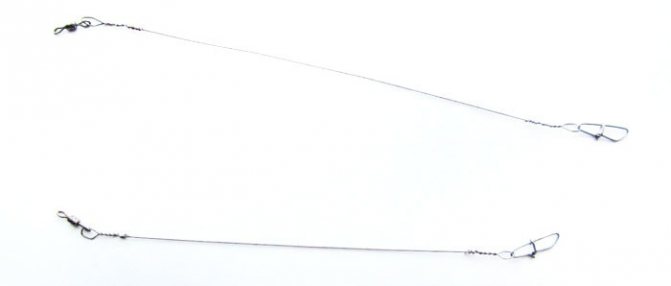
You can make leashes from steel or string yourself, because... Finding normal, elegant leashes for ultralight is almost hopeless. We take suitable material, cut off a piece, about 15-20cm. Using pliers, we form a twist of 4-5 turns, and wrap the remaining end, turn by turn, around the leash - this way it will not unravel. If we want to make a fastening at the second end, we twist it by 6-8 turns, without securing it with turns.
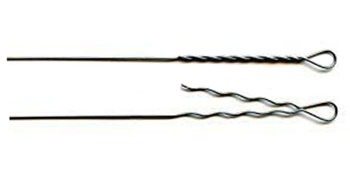
The result is a leash about 10-15cm long. The diameter of the steel is usually 0.2-0.25mm, the first string is 0.23mm. Those. This is acceptable, fairly thin leashes. And such a leash is enough to prevent the pike from cutting off our bait.
But steel has a drawback - it is hard, which worsens the performance of the bait. In this case, you can use leashes connected with Rapala knots made of elastic leash materials that can be found on sale. We take the thinnest material we could find and make excellent elastic leashes.

So, we’ve sorted out the pike – now, what about camouflaging the gear and protecting it from shellfish? The general solution here is to use a leash made of 100% fluorocarbon in microjigging gear.
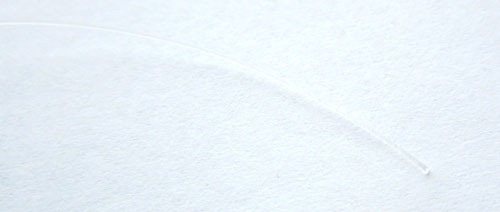
Fluorocarbon has a light refractive index close to that of water. Indeed, transparent fluorocarbon is very poorly visible against the background of a white sheet of paper, and in water it is not visible to the human eye at all. Most likely, for hiding gear from fish - this material is, today, the best. This means that the fluorocarbon leader camouflages our gear.
At the same time, 100% fluorocarbon has quite significant rigidity and surface hardness, which remarkably protects the tackle from shell rock, sharp stones and snags.
What diameter of fluorocarbon should I choose? If we catch medium-sized fish, peaceful ones, or perch using a microjig, then we take the thinnest diameters of 0.08-0.12mm.

If a large perch is caught, a solid peaceful fish is caught, a pike flies in - we increase the diameter to 0.14-0.18mm. If there is a really big one, or there is an evil shell rock on the edge that is being fished, then it is worth increasing the diameter of the flurry used to 0.2-0.23mm. Anything thicker is clearly beyond the concept of microjig.
What is a fluorocarbon leader? Some knit leashes from fluorocarbon, similar to the principle of metal leashes. But I believe that she and many fishermen will agree with me that this is not a very good practice. It is much more practical to take a piece of fluor, from 50-60cm to 1.5m long, and tie it directly to the cord. Knots such as “carrot” and “albright” are reliable and compact; they fly perfectly through the rings, without complicating fishing at all with a long leader spliced with a cord.
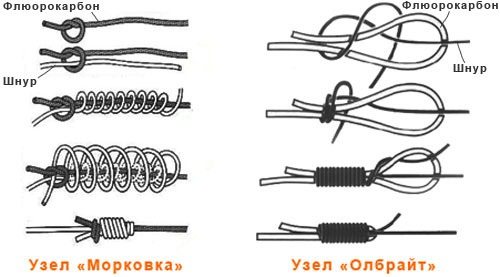
We directly tie the bait to the end of the fluorocarbon insert. If you need to change the rigs frequently and are too lazy to bandage them, you can attach a clasp to the leash. But, it’s better without additional elements - just knitting.
When asked whether it is possible to replace fluorocarbon with regular transparent fishing line - of course it is possible. Only the secrecy of the fishing line in the water is not at such a high level as that of flurry. Also, wear resistance is slightly worse. If possible, I still advise you to prefer fluorocarbon.
Share with your friends:
Categories: Tackle · Tags: Microjig, Leashes, Tackle, Spinning, Fluorocarbon





